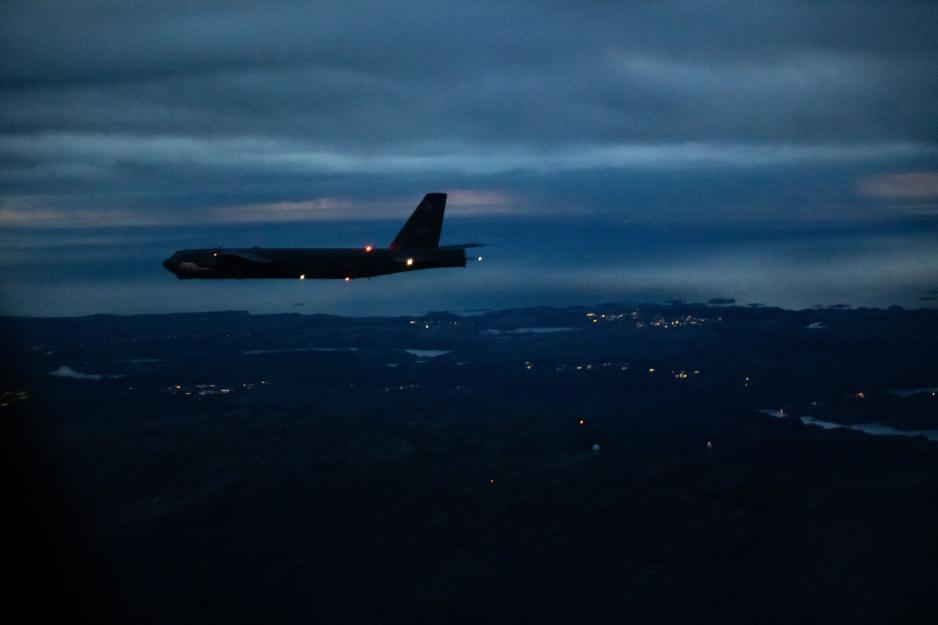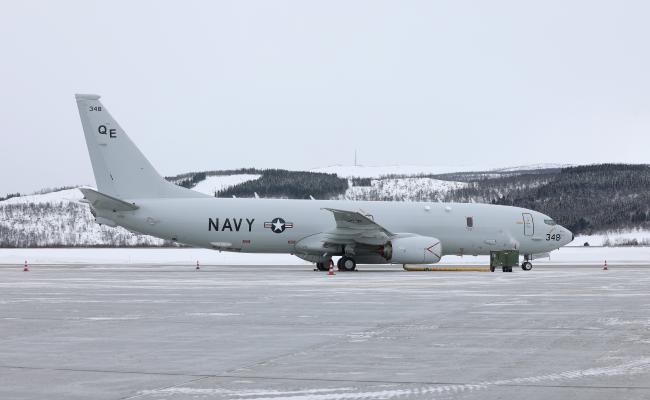US, UK and Norwegian Air Forces Exercise in the High North: F-35s Integrate With B-52

An American B-52 Stratofortress bomber flying over Bergen, Western Norway, heading northward to train with Norwegian and British forces. (Photo: Jacob Cabanero/US Air Force)
Fighters, bombers, and surveillance aircraft from the US, the UK, and Norway are now exercising to protect the High North. "The Arctic is a critical region for our collective security and global stability," says the commander of US Air Forces in Europe.
This week, Norwegian, US and UK air forces are conducting the Norwegian-led exercise Apex Buccaneer in the High North – closely integrated with units from the Norwegian Navy, Army and Special Forces.
The air assets includes Norwegian F-35 fighters and P-8 maritime patrol aircraft; a US B-52 bomber, KC-135 Stratotankers, a U-2 reconnaissance aircraft and F-35 fighters – as well as UK F-35 and Eurofighter Typhoon fighters and a RC-135 reconnaissance aircraft.
The exercise's overall aim is to conduct deterrence and protect the High North, according to the Norwegian Armed Forces.
“The Arctic is a critical region for our collective security and global stability. Training with our Norwegian and UK Allies in this environment demonstrates our shared commitment to defending NATO’s northern flank and adapting to emerging threats," says General James Hecker, Commander of the US Air Force in Europe.
"Fifth-generation platforms are pivotal to maintaining air superiority in contested spaces, and exercises like this showcase their unmatched capability," Hecker continues.
Close integration
More specifically, the combined forces practice detecting, tracking, and neutralizing a simulated enemy target on Norwegian territory.
For this, they utilize the military method F2T2 (Find, Fix, Track, Target) for efficient combat operations.
"The training showcases the Norwegian Armed Forces' ability to integrate with and leverage cutting-edge capabilities provided by the UK and the US in multi-domain operations," says Brigadier Tron Strand, Commander of the Joint Air Operations Centre at Reitan outside of Bodø in Northern Norway.
“In addition, the event provides an opportunity to develop, exercise and integrate our air command and control capability, to include F2T2, with close Allies. Together we are a credible deterrent, and if required, we are ready to defend the Arctic region," Stand maintains.
“Interoperability is vital to the defense of NATO’s northern flank. This exercise has demonstrated important enduring strengths of our alliance: our ability to understand how each other operates, to share critical information quickly, and to work seamlessly with each other,” says Group Captain Hanna Bishop, head of operations plans for the Royal Air Force.
Regular visits
The US regularly sends bombers to Norway and the neighboring countries of Sweden, Finland, and Iceland through the Bomber Task Force Mission (BTF) for strategic deterrence in the High North.
A US B-52 bomber trained in Finnish airspace with Finnish F/A-18 Hornet fighters three times last month: November 5, November 7 and November 25. On the first mission, the bomber entered Finland via Northern Norway.
In February, US B-1 bombers also operated from Northern Sweden.
In 2023, Norwegian forces exercised with American bombers in the north on several occasions:
- In the winter, Norwegian and British F-35 fighters operated with US B-52 bombers in the airspace above Nordland.
- In the summer, B-1 bombers participated in the Arctic Challenge Exercise across northern parts of Norway, Finland, and Sweden.
- In the fall, B-2 bombers were deployed in Iceland, from where they trained with Norwegian forces, among others.
Powerful defense
The US bombers B-52, B-1, and B-2 have extensive range and enormous payloads. The first and latter can also carry nuclear weapons.
"They can take off in the US and arrive in the Norwegian Sea and the Barents Sea in just a few hours, with a massive weapons load. We are actually talking 'long-range missiles' that are hard to protect oneself against here," says Col. Morten Hanche, Chief Advisor for fighter aircraft in the Norwegian Air Force.
He emphasizes that Norwegian integration with such American capacities is about deterrence.
"In Ukraine, the Russian air defense has proven efficient, and Ukrainian air forces lack room for action. The Norwegian Armed Forces wants to keep the room for action that Ukraine has lost, and the Bomber Task Force together with F-35s, sea, and land forces are not easy to defend oneself against," Hanche points out and continues:
"We must remember that what we wish to achieve is nothing [i.e. absence of armed conflict, ed. note]. Our starting point is that we respond to an armed attack against Norway, the Nordics, and NATO. At the same time, it is important that we exercise so that an enemy understands how good we are together and the potential of this cooperation. Hopefully, they will see that attacking us will not pay off."






